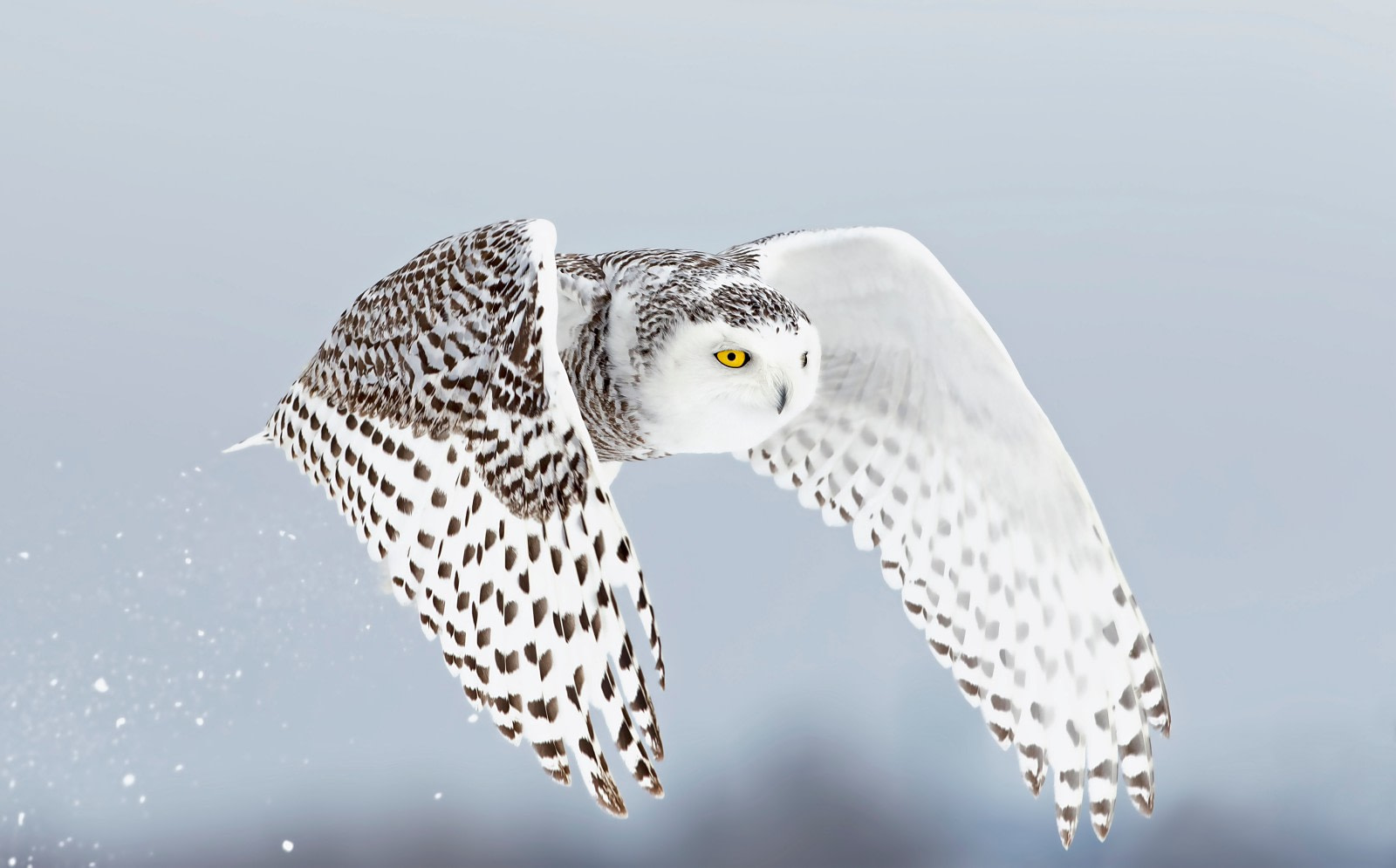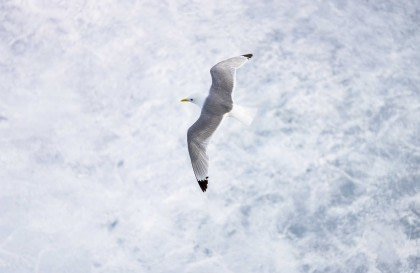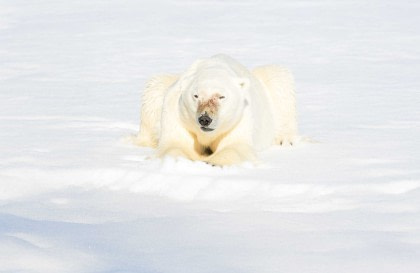Intro facts about snowy owls
The snowy owl (Bubo scandiacus), also known as the great white owl or Arctic owl, is one of the most distinctive bird species on the planet. While you won’t find them in all areas of the Arctic – they don’t exist in Svalbard due to the lack of lemmings – snowy owls are seen in the polar regions of Eurasia and North America and are a potential visitor during Greenland cruises. The binomial species name,“scandiacus,” is derived from Scandinavia, as this is where the bird was first discovered. The snowy owl is the official bird of Quebec, and they are a must-see for countless bird watchers and naturalists.
Snowy owl specs: colouring, wingspan, size
The snowy owl is noted for its beautiful white plumage and startling yellow eyes. The owlets (juvenile owls) hatch white. Their first plumage is dark grey and mottled to provide camouflage while they are still in the nest. As they get older, they start to grow their signature white plumage. Adult males are mostly white but can have some dark colouring on their wing tips. Female snowy owls have a more mottled appearance to provide camouflage for nesting on the ground, and they are also larger than males. Their beak and talons are black. Snowy owl eyes are proportionately smaller than most owl eyes are. They also cannot move their eyes, so they look around by turning their heads. Like all owls, snowy owls have a very flexible neck, which can rotate approximately 270 degrees. Their wingspan is 1.2 – 1.5 meters (4 – 5 feet), and they stand about .6 meters tall (2 feet).
The harsh tundra habitat of the snowy owl
Spanning the northern regions of Canada, Alaska, Europe, and Russia, the tundra is a habitat generally found north of 71.2 degrees latitude. The environment is cold and dry, and it begins where the taiga forest regions end. Trees do not grow on the tundra, but the habitat is rich in grass, herbs, moss, lichens, and low shrubs. The ground is rocky and hard with permafrost. The snowy owl shares this severe habitat with many species, such as the Arctic fox (Vulpes lagopus), Arctic hare (Lepus arcticus), reindeer (Rangifer tarandus), and polar bear (Ursus maritimus), to name a few.
Not quite a night owl
As the snowy owl lives in a mostly treeless environment, they can often be spotted resting on the ground or on natural perches, such as mounds or rocks. In settled areas, snowy owls will be seen perching on fences and buildings. Most of us know owls to be nocturnal (active at night), but the snowy owl is actually diurnal (active during the day). More specifically, they are crepuscular, which means they are most active at dawn and at dusk.
The lone wolf of the bird world
Snowy owls are solitary except during the breeding season, when the male assists with nesting and chick rearing. Although they are nomadic, snowy owls will become extremally territorial during the nesting and breeding season. They aggressively chase away intruders or any other predators that threaten their eggs or hatchlings. Snowy owls breed in May and June, and hatchlings can be seen over July and August. Only the female sits on the eggs, and the male provides food for her while she incubates. After snowy owl chicks are hatched, the male brings food back to the nest, and the female feeds the chicks. The chicks will be cared for by their parents for the first five or six weeks, while they grow their plumage and learn to fly and hunt.
The watch-and-wait trait of snowy owl hunting
Like all predatory birds, the snowy owl is a capable hunter. The regions of the Arctic tundra are home to the prolific and proverbial rodent, the lemming (Lemmus lemmus), and a range of other small rodents, such as voles and mice. These are a staple in the snowy owl diet. Larger prey items include the ptarmigan (Lagopus, a grouse-like bird), hares (Lepus), rabbits (Lagomorpha), and various species of ducks and geese. Hunting is done with a watch-and-wait technique. Snowy owls perch on a regular lookout point and use their highly tuned hearing and vision to locate prey. Their hearing is so good that they can even hear prey moving under the snow. Snowy owl ears are asymmetrically positioned on their heads to assist with pinpointing the source of the sounds. The feathers of the snowy owl are very soft, which helps muffle the sound of their approach when hunting.
Snowy owl Arctic adaptations
The Arctic tundra is a harsh environment, but the snowy owl is well adapted to surviving and thriving in the cold habitat. They are quite round-bodied, which helps them maintain their body heat, and they have thick plumage. Most birds have bare legs, but the snowy owl has feathers covering its legs and feet to further insulate it from the cold. Its abundant coat helps make it one of the heaviest members of the owl family, with adults weighing approximately 1.8 kilos (4 pounds). As part of their survival technique in this harsh environment, snowy owls expend as little energy as necessary. Flights are short and low to the ground, and they wait for prey as opposed to flying and searching.
Bird watching for snowy owls
Unlike many of the predatory birds from warmer regions, snowy owls are nomadic. They do not keep a regular range, as their prey can be quite scarce and seasonable. During the northern hemisphere winter, they have been known to travel as far south as Scotland. Snowy owls are active during the day and prefer weather that is dry, with little wind. Such predatory birds have regular places that they perch and scan for prey, so look for snowy owls in high areas like mounds, buildings, and fences. Snowy owls do not usually perch in trees. They are more active and abundant during the northern hemisphere summer, when their prey is breeding.
Four finishing facts about the snowy owl
- Many birds of prey swallow their prey whole. They digest the flesh, then regurgitate the bones and fur as a pellet. Scientists can use these pellets to gain information about the owl’s diet and hunting habits.
- The snowy owl is considered vulnerable by the IUCN (the International Union of Conservation for Nature).
- Snowy owls play an essential role in controlling the numbers of rodents in the Arctic tundra environment. One snowy owl can eat up to 1600 rodents in a year.
- The Harry Potter movies were responsible for a sudden boom in the interest of snowy owls as pets. However, these birds are large, strong, and have a fierce bite. This resulted in many snowy owls being abandoned at animal centres around the world.






